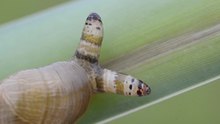Sporocyst
Sporocysts are called a developmental stage of the parasitic flukes (Trematoda), which represents a special adaptation to the host and takes place in an intermediate host .
development
Sporocysts arise from miracidia (eyelash larvae). Miracidia need snails as intermediate hosts , which they actively seek out. In most species, the Miracidium loses its eyelashes while it is being bored into the host organism. Usually in the vicinity of the invasion site, the sporocyst develops inside the host organism through restructuring and differentiation.
The development of sporocysts can vary considerably depending on the species . An asexual reproduction of the sporocysts takes place in various flukes. A mother sporocyst forms first.
The full-grown sporocyst consists of a large, undivided, non-lashed sac that has no other organs apart from muscles and germ cells . Due to the enormous growth and high reproductive capacity, the extensive nutrient uptake and the release of metabolic end products must take place via the outer shell, the neodermis . Inside the sporocyst, the germ cells begin to divide in many species, creating very similar organisms, the asexual daughter sporocysts. When the neodermis burst open, they become free and can settle in the midgut gland ( hepatopancreas ) of the snail for further development . The next generation then arises in the daughter sporocysts. These develop into cercaria in the ultimate host . In other species, so-called redia develop instead (see below).
With Leucochloridium paradoxum, for example, one or more sporocyst tubes form, which extend through the entire body of the host, the amber snail , and form a colorfully banded and pulsating "antennae magma". This attracts the ultimate host , a bird, which eats the antenna maggot and thus ingests the sporocysts.
Redien (Stablarven)
In contrast to sporocysts, redia have a short, rod-shaped intestine. The surface forms two arches near the rear end, which are used to move the redie within the screw. In most species, the surface of the neodermis is broken through by a birth opening, which is connected to the germinal balls inside. Here either redia or torn cercariae can be formed again. In some species, cercaria production only takes place after a certain number of generations. It is possible that up to 100,000 cercariae can escape after a snail is infected with a single Miracidium.
In the final host, the cercaria develop into adult, sexually mature animals.
See also: Parasites of humans
literature
- Heinz Mehlhorn, Gerhard Piekarski: Outline of parasite science ; 6th edition Heidelberg; Spektrum, Akad. Verl., 2002, ISBN 3-8274-1158-0
- Peter Wenk, Alfons Renz: Parasitology ; Georg Thieme Verlag, Stuttgart 2003, ISBN 3-13-135461-5
